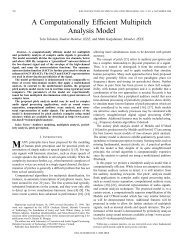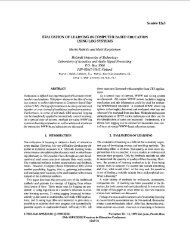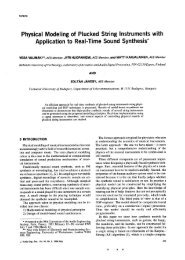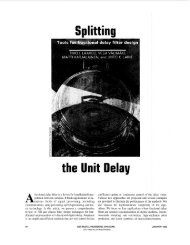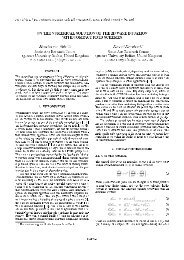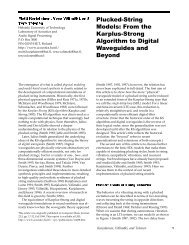Equalization of Audio Systems using Kautz Filters ... - TKK Acoustics
Equalization of Audio Systems using Kautz Filters ... - TKK Acoustics
Equalization of Audio Systems using Kautz Filters ... - TKK Acoustics
You also want an ePaper? Increase the reach of your titles
YUMPU automatically turns print PDFs into web optimized ePapers that Google loves.
PAATERO AND KARJALAINEN<strong>Equalization</strong> <strong>using</strong> <strong>Kautz</strong> filters on log-scale20a) poles16b) allpass block phasesMagnitude / dB100−10−20−30Imaginary part0.50−0.5−1−1 −0.5 0 0.5 1Real partc) tap phases and pole freqs.phase / rad4200 1 2 3angle / radd) ap phase der vs. mag resp−4010 −1 10 0Frequency / Hzphase / rad60402010.5Fig. 3: Magnitude responses <strong>of</strong> the <strong>Kautz</strong> filter tapoutputimpulse responses with respect to the proposedlogarithmic distribution <strong>of</strong> poles.00 1 2 3angle / rad01 2 3angle / radbetween the allpass operator and the correspondingorthonormal filter structure (the <strong>Kautz</strong> filter) is explainedmore thoroughly in [21]. The negated phasefunction <strong>of</strong> the allpass filter (solid line in Fig. 4(c))can be interpreted as the frequency scale mapping,whereas its derivative in Fig. 4(d) characterizes thefrequency resolution allocation introduced by thechoice <strong>of</strong> poles. The upper curve in Fig. 4(d) is thesum <strong>of</strong> magnitude responses <strong>of</strong> Fig. 3, which showsquite explicitly that the chosen resolution descriptionis somehow meaningful.The effect <strong>of</strong> pole radius tuning is demonstrated inFig. 5 <strong>using</strong> various displaying scales for the allpassphase mappings and corresponding derivatives. It isnoteworthy that the phase responses are quite insensitiveto relatively big changes in the radius pr<strong>of</strong>ile.The pole distributions are chosen purposefully closeto the unit circle to produce spiking in the resolutionmapping: there is a clear transition from a localizedresolution to a smoother overall description whenthe radius parameter R in Eq. (16) is reduced. Anothernotable aspect is that the smoothness scaleswell (evenly for the whole frequency range) with thechosen rule for the pole radius mapping.4. EXAMPLES OF LS EQUALIZATION USINGKAUTZ FILTERSIn this section we apply the proposed principles<strong>of</strong> <strong>Kautz</strong> filter design for the equalization <strong>of</strong> loudspeakerand room responses. The examination <strong>of</strong>Fig. 4: a) The poles set, b) negated phase functions<strong>of</strong> 2nd order allpass blocks, c) (allpass) tapoutputphases – overall phase (solid line) is the frequencyscale mapping (circles indicate pole positionson this mapping), and d) phase derivative (lowercurve) w.r.t. sum <strong>of</strong> <strong>Kautz</strong> filter tap-output magnituderesponses (scaled).many practical issues would need a more thoroughinvestigation; here we take only some cases that illustratethe characteristics and capabilities <strong>of</strong> <strong>Kautz</strong>equalizers.4.1. Loudspeaker equalization, Case 1In this first example <strong>of</strong> <strong>Kautz</strong> filter equalization, aninverted minimum-phase target response (with respectto a measured loudspeaker response) is usedboth directly and indirectly to construct the equalizer.The <strong>Kautz</strong> filter poles are generated in bothcases <strong>using</strong> a warped counterpart <strong>of</strong> the BU-method[20] with respect to the inverted target response.The equalizer filter order is chosen to be 38 (18 complexconjugate pole pairs and two real poles). Thepurpose <strong>of</strong> this example is to demonstrate that twovery different equalizer parametrization schemes,corresponding to Equations (4) and (8), respectively,produce very similar magnitude response equalizationresults, as depicted in Fig. 6.The early part <strong>of</strong> the measured loudspeaker impulseresponse and the LS equalized response are displayedAES 120 th Convention, Paris, France, 2006 May 20–23Page 6 <strong>of</strong> 12






